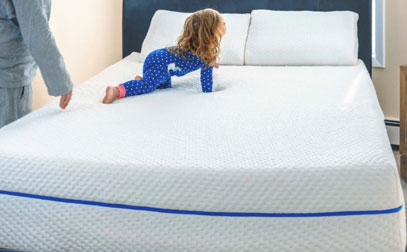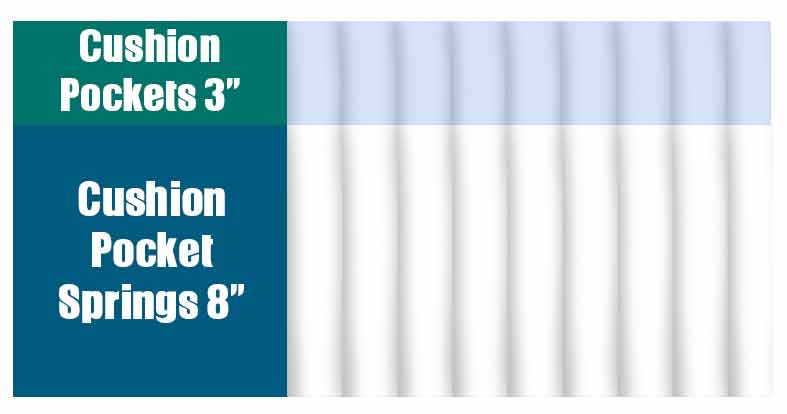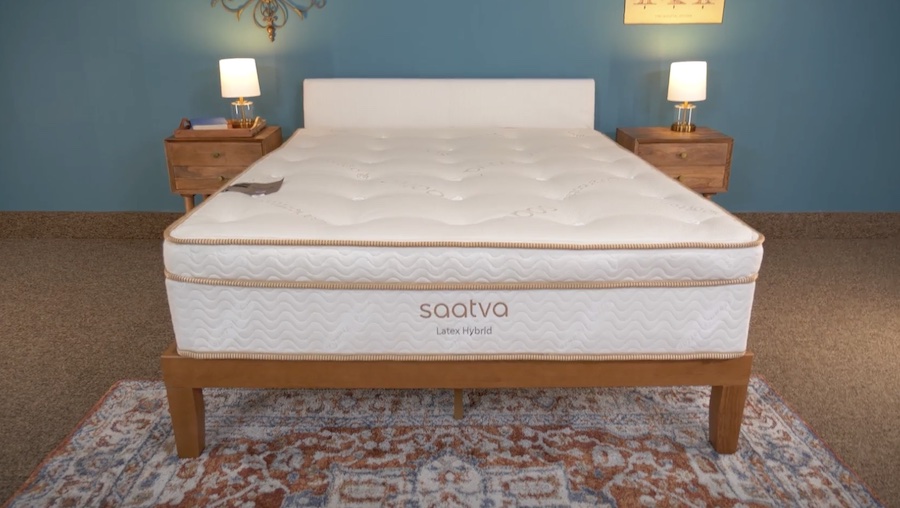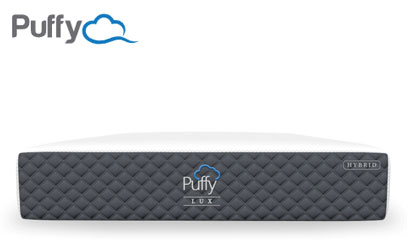Editor’s note: Kiwi Sleep was previously known as SleepOvation.
Can a mattress adapt itself to suit every sleeper?
That’s the goal of the Kiwi Sleep bed, which relies on roughly 700 individually pocketed foam columns per mattress to compress or firm up as needed to provide the ultimate personalized comfort experience.
The company claims the 700 foam columns feel like 700 tiny mattresses in one, which is an intriguing statement. Naturally, we had to see if its unique construction is as good as advertised.
Keep reading to find out our thoughts on the Kiwi Sleep mattress, including how it stacks up for certain sleep styles and preference-based features.

Kiwi Sleep Mattress

Product Details
Our Recommendation
Financing Options
Financing options are available for this mattress.
Who We Recommend The Kiwi Sleep For:
- People with pressure buildup – With an average of 700 individually pocketed foam columns in each item, buyers should feel the bed gives way beneath heavier body parts like the hips and midsection, but the springs should stand firm when needed to help support lighter areas of the body.
- Hot sleepers – The pocketed columns should promote airflow between them. This design, along with the airflow channels between the support coils, should help to keep air circulating throughout the mattress.
- Side sleepers – This bed’s personalized pressure relief should help reduce discomfort to areas like the shoulders and hips, two areas prone to pressure buildup while side sleeping.
Who We Don’t Recommend The Kiwi Sleep For:
- Fans of traditional memory foam – There should be deep sinkage in the heavier areas of the body but minimal cradling in lighter body parts. This mattress should provide more bounce and a faster response time than traditional memory materials. Shoppers should also experience enhanced pressure relief, which is often a draw for memory foam fans.
- Heavy couples – Although the Kiwi Sleep mattress may work for many couples, it’s not the best for heavy people because it can only handle up to 350 pounds. Partners weighing over 230 each will need to look for another model.
First Impressions: Firmness & Feel
Firmness Scale: 6-7/10
Please remember that firmness is a subjective characteristic and your shape will dictate how you experience a bed. A heavier person whose weight can more easily push through softer comfort and support layers may experience a bed as softer than a lightweight person. The way you are shaped could also play a role here. Consider your weight, shape, and size when evaluating firmness scores.

We rated the Kiwi Sleep at a 6-7 on our firmness scale that places beds between 1-10. Using this system, beds rated at a 1 would feel incredibly soft, while those at 10 would be very firm. With that said, we’d describe the Kiwi Sleep’s feel as medium to medium-firm.
Its medium to medium-firm feel should fit most people, including back sleepers. The foam channels provide plenty of pressure relief for the lower back while the coils ensure your body is properly aligned. Stomach sleepers, who generally steer toward firmer mattresses, should feel nicely supported, though this will depend on their weight.
How Does It Feel?
We found the cover provides a plush feel to balance the firmer support of the columns. Sinkage should be deeper in the heavier areas, while lighter body parts stay closer to the top. You should feel supportive contouring with a gentle hug, which is excellent for pressure relief around the hips, shoulders, and knees. This, combined with the airflow channels, should help keep you cool throughout the night.
What We Like About the Kiwi Sleep
- Innovative design – This design is not something we normally see in the mattress market. The foam channels are a unique design, offering not only excellent airflow but also comfortable pressure relief in the areas where needed the most.
- Removable, washable cover – Who doesn’t love being able to wash their mattress cover? It’s a small detail that makes a big difference in maintenance, especially for people with allergies.
- Individual support – The individual suspension system is made to provide tailored spinal support. The foam channels contour your curves while also providing enough firmness to keep the body in a healthy posture.
Our Kiwi Sleep Complaints
- Not your traditional memory foam bed – If you love the slow-sinking feel of memory foam, you may not like this Kiwi Sleep hybrid. This bed has a quicker response because the foam is separated into air channels.
- Lower weight capacity – The Kiwi Sleep mattress can only handle up to 350 pounds, which is really not a lot, especially for couples and co-sleepers. Heavier couples would need a mattress with a higher weight capacity.
- Too soft for some stomach sleepers – Although we described the feel as medium to medium-firm, heavy stomach sleepers may sink too deeply into the foam layer. This can throw the spine out of alignment, which is why we think they should consider a mattress with a firmer comfort layer.
Testing the Kiwi Sleep Mattress: How it Performed

We test mattresses in several sleeping positions to help you understand if they would fit your needs. Our team focuses on pressure relief and support in each position, but we also test for motion isolation, edge support, bounce, temperature regulation, and other factors that sleepers find important when buying a new bed.
For more on our testing methodology, visit our product review process page.
Sleeping Positions for Different Body Types
As mentioned, the Kiwi Sleep mattress can support up to 350 pounds. Although it has a firmer feel, the foam channels, or cushion pockets, move separately and feel softer. With that said, we think heavier people would probably sink too deeply into the foam, which can cause them to feel stuck.
| Weight | Side Sleepers | Back Sleepers | Stomach Sleepers |
| Lightweight Sleepers (-130 lbs) | ★★☆ | ★★★ | ★★★ |
| Average-Weight Sleepers (130-230 lbs) | ★★★ | ★★★ | ★★☆ |
| Heavyweight Sleepers (+230 lbs) | ☆☆☆ | ★☆☆ | ☆☆☆ |
Side Sleepers
- Lightweight Sleepers – Lightweight side sleepers should experience a nice contour and support. The cushion pockets allow a deep hug and do an excellent job of relieving pressure, but some may experience the bed as firmer, which could be a deterrent.
- Average-Weight Sleepers – We feel that average-weight side sleepers should get a balance of pressure relief and support from the medium to medium-firm construction.
- Heavyweight Sleepers – Heavy side sleepers may prefer a firmer mattress. We think they would sink too deeply into the cushion pockets, compromising support.
Back Sleepers
- Lightweight Sleepers – Back sleepers weighing under 130 pounds should benefit from the Kiwi Sleep. The cushion pockets move separately, allowing the mattress to contour your lower back without letting you sink too deeply.
- Average-Weight Sleepers – The medium to medium-firm feel of this mattress should work well for average-weight back sleepers. The coils keep the body aligned while the cushion pockets contour the curves to relieve pressure.
- Heavyweight Sleepers – Heavy back sleepers may sink too deeply in the hip area because they’re likely to experience this bed as soft. Although it may work for some back sleepers, we think most people in this group should consider a firmer option.
Stomach Sleepers
- Lightweight Sleepers – Lightweight stomach sleepers should feel nicely supported by the Kiwi Sleep mattress, which feels firmer in this case.
- Average-Weight Sleepers – We think stomach sleepers weighing 130 to 230 pounds should benefit from the bed’s medium firmness and pressure relief. However, those closer to 230 pounds may want a firmer bed to keep the hips aligned.
- Heavyweight Sleepers – Although this bed is medium-firm, heavy sleepers are likely to experience it as softer. We think they’d find their hips sinking too deeply into the foam layer, which is a problem because this can cause their lower back to curve too much.
Pressure Relief
5/5
Pressure relief is where this bed really shines. Firmer mattresses don’t often have excellent pressure-relieving capabilities, but the trick here is in the cushion pockets. The foam comfort layer is cut into pieces that allow the layer to move in different ways according to the pressure applied. This means heavier parts should sink more for higher relief, and lighter-weight body parts should stay on top of the mattress as they don’t need as much relief.
Is the Kiwi Sleep Mattress Good for Pain Relief?
We think the Kiwi Sleep mattress is a good option for people with pain as it combines support and pressure relief. However, sleepers should be careful about their weight and how it matches the firmness level of this mattress because some people may experience it as firmer or softer.
The “tiny mattresses” within the constructions are made to dissipate your weight evenly, which helps ensure there’s no pressure buildup in any sleeping position.
Back Pain
People with back pain should appreciate the bed’s mid-range firmness. The coils do a good job of supporting the body to keep everything aligned in a healthy posture, while the foam contours the curves to relieve pressure. We think this bed may even be a good option for back sleepers with lower back pain as cushion pockets dissipate weight and contour the small of your back.
Hip Pain
We think that people with hip pain will like how the memory foam hugs the body. If you’re a lightweight side sleeper, you may want a softer bed to relieve pressure and pain in the hips. Average-weight side sleepers with hip pain should sink deeper, which helps take the pressure off the hips.
Shoulder Pain
Sleepers with shoulder pain should benefit the same way people with hip pain do. In most cases, the relief level depends on your exact weight and sleeping position, but we think the Kiwi Sleep should generally be good for most people with shoulder pain.
Support
5/5
The Kiwi Sleep is a hybrid mattress with a medium to medium-firm feel. We noticed a nice level of support and pressure-relieving sinkage with this bed.
The mattress provides enough lumbar support to keep the spine in neutral, while the individualized foam columns contour the body. The springs are a little bouncy, and although the foam on top feels plush, these provide firm support.
Motion Transfer
3/5
Although the coils of this hybrid are on the firmer side, the foam feels more plush. Foam usually does a good job of isolating motion, but in this case, we think it’s not at its best.
In other words, we noticed some motion transfer in the Kiwi Sleep mattress when we tested it. We don’t think the transfer would be enough to disrupt your sleep when your partner tosses and turns, but it’s there, and it may be an issue if you’re a particularly light sleeper.
Temperature Regulation / Cooling
4/5
Hybrid mattresses are more breathable than all-foam models because the coils help foster airflow. However, the foam on top can make things hot for most people. Luckily, we don’t think that would be the case here.
The Kiwi Sleep mattress does have foam in the comfort layer, but the unique design of cushion pockets allows more breathability. Unlike a single block of memory foam, the cushion pockets move and allow more air to pass through. Nonetheless, particularly hot sleepers may want to look for a cooling mattress with advanced temperature-regulating features.
Bounce
4/5
If you press into the first layer of the Kiwi Sleep mattress, you can easily notice the fast response coming from the cushion pockets. Memory foam may be known for its slow response, but we assume this innovative design allows it to move faster. On top of that, there’s more bounce coming from the coils, which can help combination sleepers switch positions.
Edge Support
3/5
Compression may be slightly noticeable when sitting on the edge of the bed, which is quite common for a bed-in-a-box product. Shoppers should notice more solid edge support when lying at the edge, which should help make the bed feel a little larger, expanding the usable sleep surface.
Performance for Couples
3/5
We think this bed is a good option for most couples sharing a bed but be mindful about its weight capacity. The Kiwi Sleep can only handle up to 350 pounds, which may not be enough for some couples.
When it comes to bounce, motion isolation, and edge support, though, we think the mattress should satisfy couples and co-sleepers.

Kiwi Sleep Mattress

Product Details
Our Recommendation
Financing Options
Financing options are available for this mattress.
Preference-Based Features
Washable Cover
The Kiwi Sleep mattress comes with a removable, washable cover that makes it easier to keep your sleep surface clean.
Bed-in-a-Box Shipping
This hybrid mattress arrives in a box and is easy to unpack. The bed unrolls and takes only a few hours to come to its original shape before you can use it.
Seven Sizes
While most mattresses come in six standard sizes, the Kiwi Sleep is also available in Split King for even more customization.
Made in the USA
Construction: What’s Inside the Kiwi Sleep?
The Kiwi Sleep mattress features a foam and pocketed steel coil design. This bed-in-a-box product should be compatible with most flat, solid surfaces, including adjustable frames and box springs with boards placed on top. Slatted bases, however, are not recommended to prevent the mattress from sagging between the slats.
The knit polyester and elastane cover on the Kiwi Sleep contains a quilted mattress pad for extra support and comfort. The cover is stitched in a way that promotes air channels to help circulate air and move heat away from the body, an advantage for those who want a breathable sleep space. The plush, white cover can be removed for washing via a convenient, bright blue zipper.
The SleepOveration mattress is a total of 12 inches in height.

- The comfort layer sits below the cover and is comprised of 3-inch Cushion Pockets made of high-density hybrid foam cut into cylinders and covered in fabric. These individual columns should perform similarly to individually pocketed coils, compressing and moving with the body for individualized support, as well as plush pressure relief.
- The support layer makes the bottom of the bed and consists of 8-inch high carbon steel Cushion Pocket Springs connected to the upper layer to provide movability and easier compression. This layer acts as the base for this item and should provide support throughout the entire bed.
Unboxing & Off-Gassing
Unpacking this mattress was a breeze, but keep in mind you should first move the box to your bedroom. Once you do, unpack the mattress and place it on your foundation of choice. Remove the plastic cover and let the bed unroll for as long as needed. Once it unrolls and inflates, you’ll know it’s ready for use.
If you notice any off-gassing, note that the odor is normal for bed-in-a-box mattresses and will dissipate.
Certifications
- Eco-Friendly Certifications – It has a GREENGUARD Gold certification that reflects the product’s ability to meet some of the world’s most rigorous emissions standards.
- The foams in this bed are CertiPUR-US® certified. CertiPUR-US® is a third-party program that ensures the foams meet rigorous health and safety standards. This means they don’t contain harmful substances like ozone depleters, PBDEs, heavy metals, formaldehyde, and phthalates. They should also have low volatile organic compound (VOC) emissions.
Coupons, Trials, Warranties, and Shipping
- Shipping – This product ships for free in the contiguous United States. An extra fee may be charged to ship to Alaska, Hawaii, and Canada.
- Trial – Shoppers can try out their new mattress using the 100-night trial.
- Warranty – Kiwi Sleep offers a 10-year warranty with this mattress.
- Return Policy – Returns are free and easy within the trial period, so if you don’t like the mattress, make sure to initiate the return before the 100 nights are up.
Sizes & Prices
| Size | Dimensions (inches) | Price (w/o discount) |
| Twin | 39″ x 75″ x 12″ | $1,624 |
| Twin XL | 39″ x 80″ x 12″ | $1,949 |
| Full | 54″ x 75″ x 12″ | $2,249 |
| Queen | 60” x 80” x 12” | $2,649 |
| King | 76″ x 80″ x 12” | $3,099 |
| Cali King | 72″ x 84″ x 12” | $3,099 |
| Split King | 78” x 80” x 12” | $3,399 |
Frequently Asked Questions
Who is the owner of Kiwi Sleep?
Kiwi Sleep is owned by Richard Codos, the company founder and CEO. He is also the inventor of the tiny mattress support system.
How much does a Kiwi Sleep mattress cost?
A Queen-size Kiwi Sleep mattress costs just over 2,600 dollars, and their smallest size, Twin, costs just over 1,600 dollars.
Is the Kiwi Sleep mattress flippable?
The Kiwi Sleep isn’t a flippable mattress. The layers are stacked to provide a certain level of firmness and quality of performance, so flipping it around would disrupt this order.
Kiwi Sleep vs. Other Brands
Kiwi Sleep vs. Saatva Latex Hybrid
Product
Type
Score

Product
Type
Score
Who We Recommend the Kiwi Sleep For
- People seeking pressure relief
- Sleepers after an innovative design
- Back sleepers
Who We Recommend the Saatva Latex Hybrid For
- People with back pain
- Sleepers with allergies
- Luxury shoppers
Read our Saatva Latex Hybrid mattress review if you think this Saatva is right for you
Kiwi Sleep vs. Puffy Lux
Product
Type
Score
Who We Recommend the Kiwi Sleep For
- Lightweight sleepers
- People with hip pain
- Those after a firmer bed
Who We Recommend the Puffy Lux For
- Side sleepers
- Those who want a softer bed
- Luxury shoppers
Read our Puffy Lux Hybrid review if you think this bed may be for you.
Our Verdict
This bed promises “next-level comfort” through the use of “700 tiny mattresses” combined into one personalized sleep experience.
With adaptable pressure relief that firms up or compresses to meet your individual needs, a universal medium to medium-firm comfort level, and a cool sleep experience, most shoppers may be inclined to agree with that mission statement.
Although it may not work for heavy couples and some stomach sleepers, we think the innovative construction should work for many others. The Kiwi Sleep earned an overall score of 4.1 out of 5.

Kiwi Sleep Mattress

Product Details
Our Recommendation
Financing Options
Financing options are available for this mattress.

Olivera Jancikin
Content Writer
About Author
Olivera is a content writer for Sleep Advisor and is enthusiastic about sleep. She firmly believes in the benefits of daytime naps on top of getting a full 8-hour sleep at night.
Combination Sleeper

